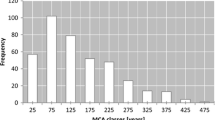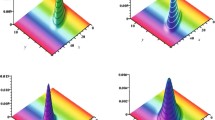Abstract
The interactions between trees in a forest are manifested in a decrease in phytomass growth and the weakening and disappearance of some trees. One of the ways to identify the nature of the relationship between trees in a forest is to study the current functions of distribution of trees in the stand in terms of height and trunk diameter. In this case, various functions are used for description: gamma function, normal and logarithmically normal functions, Weibull function, etc. To theoretically substantiate the choice of a particular distribution to describe the diameters and heights of trees in a stand, in this paper, it is proposed to use the Gaussian Orthogonal Ensemble (GOE) model used in nuclear physics to describe the distribution of energy levels of atomic nuclei and to characterize interactions in chaotic systems. It is shown that the interactions both in the atomic nucleus and in the forest stand can be described by a general model. To describe the taxation indicators of trees, the characteristics of reciprocal heights and diameters are introduced. The GOE model for the forest stand was verified according to the inventory data. It is shown that the parameters of the normalized GOE model do not depend on the age of the stand.









Similar content being viewed by others
REFERENCES
Bailey, R.L. and Dell, T.R., Quantifying diameter distribution with the Weibull function, For. Sci., 1973, vol. 19, no. 2, pp. 97–104.
Bredford, S.C., The documentary chaos, in Documentation, Bredford, S.C., Ed., London: Crosby Lockwood, 1948, pp. 106–121.
Buzykin, A.I., Sekretenko, O.P., and Khlebopros, R.G., Dannye nablyudenii i analiz gorizontal’noi struktury na pyati probnykh ploshchadyakh v odnovozrastnykh drevesnykh tsenozakh (Observational Data and Analysis of the Horizontal Structure on Five Sample Plots in Coeval Tree Cenoses), Krasnoyarsk: Inst. Lesa im. V.N. Sukacheva Sib. Otd. Ross. Akad. Nauk, 2009.
Cao, Q.V., Predicting parameters of a Weibull function for modelling diameter distribution, For. Sci., 2004, vol. 50, no. 5, pp. 682–685.
Darwin, Ch., On the Origin of Species by Means of Natural Selection, or the Preservation of Favoured Races in the Struggle for Life, London: John Murray, 1859.
De Lima, R.A.F., Batista, J.L.F., and Prado, P.I., Modeling tree diameter distributions in natural forests: An evaluation of 10 statistical models, For. Sci., 2015, vol. 61, pp. 320–327.
Dwight, H.B., Tables of Integrals and Other Mathematical Data, New York: Macmillan, 1961.
Dyson, F.J., Statistical theory of the energy levels of complex systems, J. Math. Phys., 1962, vol. 3, pp. 140–175.
Ek, A.R., Issos, J.N., and Bailey, R.L., Solving for Weibull diameter distribution parameters to obtain specifed mean diameters, For. Sci., 1975, vol. 21, pp. 290–292.
Fonseca, T.F., Marques, C.P., and Parresol, B.R., Describing maritime pine diameter distributions with Johnson’s SB distribution using a new all-parameter recovery approach, For. Sci., 2009, vol. 55, no. 4, pp. 367–373.
Ganina, N.V., Distribution of trees by diameter using the Weibull function, Lesovedenie, 1984, no. 2, pp. 17–19.
Gnedenko, B.V., Kurs teorii veroyatnostei (Probability Course), Moscow: Nauka; Gl. Red. Fiz.-Mat. Lit., 1988.
Gómez-Garcia, E., Crecente-Campo, F., Tobin, B., Hawkins, M., Nieuwenhuis, M., and Diéguez-Arenda, U., A dynamic volume and biomass growth models system for even-aged downy birch stands in south-western Europe, Forestry, 2014, vol. 87, pp. 165–176.
Gorgoso-Varela, J.J. and Rojo-Alboreca, A., Short communication: A comparison of estimation methods for fitting Weibull and Johnson’s SB functions to pedunculate oak (Quercus robur) and birch (Betula pubescens) stands in northwest Spain, For. Syst., 2014, vol. 23, no. 3, pp. 500–505.
Gorgoso-Varela, J.J., Garcia-Villabrille, J.D., Rojo-Alboreca, A., Gadow, K., and Alvarez-Gonzalez, J.G., Comparing Johnson’s SBB, Weibull and Logit-Logistic bivariate distributions for modeling tree diameters and heights using copulas, For. Syst., 2016, vol. 25, no. 1, p. eSC07. https://doi.org/10.5424/fs/2016251-08487
Jaworski, A. and Podlaski, R., Modelling irregular and multimodal tree diameter distributions by finite mixture models: An approach to stand structure characterization, J. For. Res., 2012, vol. 17, no. 1, pp. 79–88.
Jin, X., Li, F., Jia, W., and Zhang, L., Modelling and predicting bivariate distributions of tree diameter and height, Sci. Silvae Sin., 2013, vol. 49, no. 6, pp. 74–82.
Kangas, A. and Maltamo, M., Performance of percentile based diameter distribution prediction and Weibull method in independent data sets, Silva Fennica, 2000, vol. 34, pp. 381–398.
Lebkov, V.F., Dynamics of the pine trees distribution according to the morphometric parameters of the trunk and crown, Lesovedenie, 1990, no. 5, pp. 57–68.
Lebkov, V.F. and Kaplina, N.F., Regularities and estimates of the structure of pine forest stands, Lesn. Khoz., 2008, no. 3, pp. 39–41.
Lei, Y., Evaluation of three methods for estimating the Weibull distribution parameters of Chinese pine (Pinus tabulaeformis), J. For. Sci., 2008, vol. 54, pp. 566–571.
Li, F., Zhang, L., and Davis, C.J., Modelling the joint distribution of tree diameters and heights by bivariate generalized beta distribution, For. Sci., 2002, vol. 48, no. 1, pp. 47–58.
Lin, C., Tsogt, K., and Zandraabal, T., A decompositional stand structure analysis for exploring stand dynamics of multiple attributes of a mixed-species forest, For. Ecol. Manage., 2016, vol. 378, pp. 111–121.
Liu, F., Li, F., Zhang, L., and Jin, X., Modelling diameter distributions of mixed-species forest stands, Scand. J. For. Res., 2014, vol. 28, no. 7, pp. 653–663.
Maltamo, M., Puumalainen, J., and Päivinen, R., Comparison of beta and Weibull functions for modelling basal area diameter distribution in stands of pinus sylvestris and picea abies, Scand. J. For. Res., 1995, vol. 10, pp. 284–295.
Maltamo, M., Kangas, A., Uuttera, J., Torniainen, T., and Saramäki, J., Comparison of percentile based prediction methods and the Weibull distribution in describing the diameter distribution of heterogeneous Scots pine stands, For. Ecol. Manag., 2000, vol. 133, pp. 263–274.
Malthus, T.R., An Essay on the Principle of Population, As It Affects the Future Improvement of Society, London: J. Johnson, 1798.
Mateus, A. and Tomé, M., Modeling the diameter distribution of Eucalyptus plantations with Johnson’s probability density function: Parameters recovery from a compatible system of equations to predict stand variables, Ann. For. Sci., 2011, vol. 68, pp. 325–335.
Mehta, M.L., Random Matrices, Amsterdam: Elsevier, 2004.
Mehtätalo, L., de-Miguel, S., and Gregoire, T.G., Modelling height-diameter curves for prediction, Can. J. For. Res., 2015, vol. 45, pp. 826–837.
Mergani, C.J. and Sterba, H., Characterisation of diameter distribution using the Weibull function: Method of moments, Eur. J. For. Res., 2006, vol. 125, pp. 427–439.
Newton, P.F., Lei, Y., and Zhang, S.Y., A parameter recovery model for estimating black spruce diameter distributions within the context of a stand density management diagram, For. Chron., 2004, vol. 80, pp. 349–358.
Nord-Larsen, T. and Cao, Q.V., A diameter distribution model for even-aged beech in denmark, For. Ecol. Manage., 2006, vol. 231, pp. 218–225.
Ostreikovskii, V.A., Teoriya nadezhnosti (Reliability Theory), Moscow: Vysshaya Shkola, 2003.
Ozcelik, R., Cao, Q.V., Trincado, G., and Nilsum, G., Predicting tree height from tree diameter and dominant height using mixed-effect and quantile regression models for two species in Turkey, For. Ecol. Manage., 2018, vols. 419–420, pp. 240–248.
Palahí, M., Pukkala, T., Blasco, E., and Trasobares, A., Comparison of beta, Johnson’s SB, Weibull and truncated Weibull functions for modelling the diameter distribution of forest stands in Catalonia (north-east of Spain), Eur. J. For. Res., 2007, vol. 126, pp. 563–571.
Pareto, V., Cours d’economie politique, Lausanne: F. Rouge, 1896.
Podlaski, R., Forest modelling: The gamma shape mixture model and simulation of tree diameter distributions, Ann. For. Sci., 2017, vol. 74, no. 2, pp. 29–39.
Pogoda, P., Ochał, W., and Orzeł, S., Modeling diameter distribution of black alder (Alnus glutinosa (L.) Gaertn.) stands in Poland, Forests, 2019, vol. 10, pp. 412–428.
Pollard, J.H., A Handbook of Numerical and Statistical Techniques, Cambridge: Cambridge Univ. Press, 1979. 368 p.
Poudel, K.P. and Cao, Q.V., Evaluation of methods to predict Weibull parameters for characterizing diameter distributions, For. Sci., 2013, vol. 59, no. 2, pp. 243–252.
Ryzhkov, O.V., Distribution of trees by diameter in protected forests of the central forest-steppe, Lesovedenie, 2000, no. 5, pp. 43–52.
Stockmann, H.-J., Quantum Chaos. An Introduction, Cambridge: Cambridge Univ. Press, 2007.
Sharma, R.P., Vacek, Z., Vacek, S., and Kucera, M., Modelling individual tree height-diameter relationships for multi-layered and multi-species forests in central Europe, Tree, 2019, vol. 33, no. 1, pp. 103–119.
Shiver, B.D., Sample sizes and estimation methods for the Weibull distribution for unthinned slash pine plantation diameter distributions, For. Sci., 1988. vol. 34, pp. 809–814.
Soukhovolsky, V. and Ivanova, Y., Modeling production processes in forest stands: An adaptation of the Solow growth model, Forests, 2018, vol. 9, pp. 391–403.
Soukhovolsky, V.G. and Kovalev, A.V., Modeling the coronavirus epidemic as a phase transition, Zh. Obshch. Biol., 2020, vol. 81, no. 5, pp. 362–373.
Soukhovolsky, V.G., Tarasova, O.V., and Kovalev, A.V., Modeling critical events in forest insect populations, Zh. Obshch. Biol., 2020, vol. 81, no. 5, pp. 374–386.
Stankova, T.V. and Zlatanov, T.M., Modelling diameter distribution of Austrian black pine (Pinus nigra Arn.) plantations: A comparison of the Weibull frequency distribution function and percentile-based projection methods, Eur. J. For. Res., 2010, vol. 129, pp. 1169–1179.
Tret’yakov, N.V., Zakon edinstva v stroenii nasazhdenii (The Law of Uniformity in the Structure of Plantations), Moscow: Novaya Derevnya, 1927.
Tsogt, K. and Lin, C., A flexible modelling of irregular diameter structure for the volume estimation of forest stands, J. For. Res., 2014, vol. 19, pp. 1–11.
Usol’tsev, V.A., Produktsionnye pokazateli i konkurentnye otnosheniya derev’ev. Issledovanie zavisimostei (Production Indicators and Competitive Relations of Trees. Dependency Research), Yekaterinburg: Ural. Gos. Lesotekh. Univ., 2013.
Van Laar, A. and Akca, A., Forest Mensuration, Dordrecht: Springer, 2007.
Weibull, W., A statistical distribution function of wide applicability, J. Appl. Mech., 1951, vol. 18, pp. 293–297.
Wigner, E.P., On the statistical distribution of the widths and spacing of nuclear resonance levels, Math. Proc. Cambridge Philos. Soc., 1951, vol. 47, pp. 790–798.
Wigner, E.P., Group Theory and its Application to the Quantum Mechanics of Atomic Spectra, New York: Academic, 1959.
Yule, G.U., A mathematical theory of evolutionary based on conclusions of Dr. J.C. Willis, F.R.S, Philos. Trans. R. Soc., B, 1924, vol. 213, pp. 21–87.
Zasada, M. and Cieszewski, C.J., A finite mixture distribution approach for characterizing tree diameter distributions by natural social class in pure even-aged Scots pine stand in Poland, For. Ecol. Manage., 2005, vol. 204, pp. 145–158.
Zee, A., Quantum Field Theory in a Nutshell, Princeton, N.J.: Princeton Univ. Press, 2003.
Zhang, L., Gove, J.H., Liu, C., and Leak, W.B., A finite mixture of two Weibull distributions for modelling the diameter distributions of rotated-sigmoid, uneven-aged stands, Can. J. For. Res., 2001, vol. 31, pp. 1654–1659.
Zhang, L., Kevin, C.P., and Chuanmin, L., A comparison of estimation methods for fitting Weibull and Johnson’s SB distributions to mixed spruce-fir stands in north-eastern North America, Can. J. For. Res., 2003, vol. 33, pp. 1340–1347.
Zhang, L. and Liu, C., Fitting irregular diameter distributions of forest stands by Weibull, modified Weibull, and mixture Weibull models, J. For. Res., 2006, vol. 11, pp. 369–372.
Zhang, X. and Lei, Y., A linkage among whole-stand model, individual-tree model and diameter-distribution model, J. For. Sci., 2010, vol. 56, pp. 600–608.
Zipf, G.K., Human Behaviour and the Principle of Least Effort, Cambridge: Addison-Wesley, 1949.
Author information
Authors and Affiliations
Corresponding author
Ethics declarations
COMPLIANCE WITH ETHICAL STANDARDS
Conflict of interest. The authors declare that they have no conflicts of interest.
Statement of the welfare of humans or animals. The article does not contain any studies involving humans or animals in experiments performed by any of the authors.
Additional information
Translated by E. Makeeva
Rights and permissions
About this article
Cite this article
Soukhovolsky, V.G., Ivanova, Y.D. & Tarasova, O.V. What Is Common between Ecology and Nuclear Physics: A Random Matrix Model for the Distribution of Trees in a Stand by Inventory Data. Biol Bull Rev 13, 397–407 (2023). https://doi.org/10.1134/S2079086423050067
Received:
Revised:
Accepted:
Published:
Issue Date:
DOI: https://doi.org/10.1134/S2079086423050067




